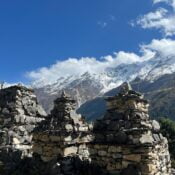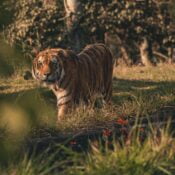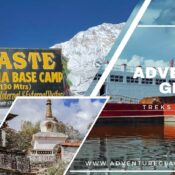The Ultimate Guide to the Annapurna Circuit Trek: Exploring the Costs and Budgeting Tips


Are you an adventurous soul looking to embark on an unforgettable journey through the breathtaking landscapes of Nepal? If so, the Annapurna Circuit Trek should be at the top of your bucket list. This ultimate guide will provide you with valuable insights into the costs involved and essential budgeting tips to ensure a smooth and affordable trekking experience.
The Annapurna Circuit Trek is renowned for its mesmerizing views of snow-capped peaks, lush valleys, and charming traditional villages. Spanning about 160 miles, this epic route takes you through diverse terrain, including challenging mountain passes and serene pine forests. It's an experience that will push your limits, test your resilience, and reward you with moments of awe-inspiring beauty.
In this guide, we'll delve into the expenses you can expect while trekking the Annapurna Circuit. From permits and accommodation to meals and transportation, we'll help you understand the various aspects of budgeting for this adventure. Whether you're a seasoned trekker or a novice, our tips will enable you to make informed decisions and optimize your expenses without compromising on the quality of your journey.
Get ready to lace up your boots and embark on an extraordinary adventure as we unravel the secrets of trekking the Annapurna Circuit while keeping your budget intact.
Highlights of the Annapurna Circuit Trek
The Annapurna Circuit Trek offers a multitude of highlights that make it a must-do adventure for trekking enthusiasts. One of the main attractions is the stunning views of the Annapurna mountain range, which includes peaks like Annapurna I, Annapurna II, and Machhapuchhre (also known as Fish Tail). These towering snow-covered peaks create a backdrop of unparalleled beauty throughout the trek.
In addition to the breathtaking mountain views, the Annapurna Circuit Trek takes you through diverse landscapes. You'll pass through lush green valleys, terraced farmlands, dense rhododendron forests, and barren high-altitude deserts. Each day brings new scenery, offering a captivating experience that will leave you in awe of the natural beauty of Nepal.
The trek also provides an opportunity to immerse yourself in the unique culture and traditions of the local communities. Along the way, you'll encounter traditional villages inhabited by Gurung, Thakali, and Manangba people, who are known for their warm hospitality. Interacting with the locals and learning about their way of life adds a cultural dimension to the trek, making it a truly enriching experience.
Planning and Preparation for the Annapurna Circuit Trek
Before embarking on the Annapurna Circuit Trek, careful planning and preparation are essential. Firstly, consider the best time to undertake the trek. The peak seasons, from March to May and September to November, offer the best weather conditions and clear mountain views. However, these periods can be crowded, so if you prefer a quieter experience, consider trekking during the offseason.
Next, make sure you have the necessary permits for the trek. You'll need an Annapurna Conservation Area Permit (ACAP) and a Trekkers' Information Management System (TIMS) card. These permits can be obtained in Kathmandu or Pokhara, and the fees contribute to the conservation and maintenance of the trekking trails.
It's also crucial to assess your fitness level and prepare accordingly. The Annapurna Circuit Trek involves long days of walking, often on steep and rugged terrain. Engage in regular physical exercise and hiking practice to build your stamina and endurance. Additionally, consult with a healthcare professional to ensure you're in good health and discuss any necessary vaccinations or medications.
Costs and Budgeting for the Annapurna Circuit Trek
Trekking the Annapurna Circuit can be done on a range of budgets, depending on your preferences and priorities. On average, the total cost for the trek, including permits, accommodation, meals, transportation, and miscellaneous expenses, can vary between $800 to $1500 per person for around 15 days. However, it's important to note that these figures are estimates, and costs can fluctuate depending on factors such as the season, accommodation choices, and personal spending habits.
Accommodation options along the Annapurna Circuit Trek
During the trek, you'll find a variety of accommodation options to suit different budgets and preferences. Tea houses, also known as guesthouses, are the most common type of lodging along the trail. These establishments offer basic but comfortable rooms with shared bathrooms. The cost of a room in a tea house can range from $5 to $20 per night, depending on the location and facilities.
For those seeking a more luxurious experience, some tea houses and lodges offer deluxe rooms with private bathrooms and amenities such as hot showers and Wi-Fi. However, be prepared to pay higher prices for these upgraded accommodations, ranging from $20 to $50 per night.
In addition to tea houses, camping is another option for accommodation on the Annapurna Circuit Trek. If you prefer the flexibility and solitude of camping, you can rent camping gear from Kathmandu or Pokhara and set up your tent along the trail. Keep in mind that camping requires more preparation and carries additional costs for permits and equipment rental.
Food and Drink on the Annapurna Circuit Trek
During the trek, you'll find a variety of dining options along the trail. Most tea houses and lodges offer a menu of traditional Nepali cuisine, as well as international dishes such as pasta, pizza, and momos (dumplings). Meals at tea houses are relatively affordable, with prices ranging from $5 to $10 per meal.
It's important to stay hydrated and nourished during the trek. Bottled water is readily available at tea houses, but it can be expensive and contribute to plastic waste. To save money and reduce your environmental impact, consider carrying a water purification system or water purification tablets to treat water from natural sources.
Trekking permits and fees
Obtaining the necessary permits and paying the associated fees is an essential part of preparing for the Annapurna Circuit Trek. As mentioned earlier, you'll need an Annapurna Conservation Area Permit (ACAP) and a Trekkers' Information Management System (TIMS) card.
The ACAP costs around $20 for foreign nationals and NPR 2000 for SAARC nationals. The TIMS card fee is $20 for individual trekkers and $10 for trekkers in a group. These permits can be obtained in Kathmandu or Pokhara, and it's advisable to carry multiple photocopies of the permits for checkpoints along the trail.
Essential gear and equipment for the Annapurna Circuit Trek
Having the right gear and equipment is crucial for a safe and comfortable trekking experience. Here's a list of essential items you'll need for the Annapurna Circuit Trek:
- Trekking boots: Invest in a good pair of sturdy, waterproof trekking boots that provide ankle support.
- Backpack: Choose a backpack with a capacity of 40-60 liters to carry your essentials.
- Clothing layers: Pack a combination of lightweight, moisture-wicking base layers, insulating mid-layers, and waterproof outer layers.
- Sleeping bag: Opt for a sleeping bag suitable for sub-zero temperatures to ensure a good night's sleep in the colder regions.
- Trekking poles: Consider using trekking poles to provide stability and reduce strain on your knees during steep descents.
- Headlamp: A headlamp is essential for navigating in low-light conditions and during early morning or late evening hikes.
- First aid kit: Carry a basic first aid kit with essentials such as bandages, antiseptic ointment, painkillers, and altitude sickness medication.
Safety precautions and considerations
Trekking in the mountains comes with inherent risks, and it's crucial to prioritize safety throughout your journey. Here are some important safety precautions and considerations to keep in mind:
- Altitude sickness: Acclimatization is key to avoiding altitude sickness. Ascend gradually, take rest days, and stay hydrated. Familiarize yourself with the symptoms of altitude sickness and be prepared to descend if necessary.
- Weather conditions: The weather in the mountains can be unpredictable. Check the weather forecast regularly and pack appropriate clothing layers for varying conditions.
- Travel insurance: Purchase comprehensive travel insurance that covers emergency medical evacuation and trekking at high altitudes.
- Hiring a guide or porter: If you're new to trekking or prefer additional support, consider hiring a guide or porter. A guide can provide valuable insights, navigate the trail, and offer assistance in case of emergencies. A porter can lighten your load and allow you to focus on enjoying the trek.
Conclusion and final tips for the Annapurna Circuit Trek
Trekking the Annapurna Circuit is an adventure of a lifetime, and with careful planning and budgeting, it can be an affordable experience. Research and compare prices for permits, accommodation, and transportation to find the best deals. Consider traveling during the offseason to save money and enjoy a quieter trek.
Pack light but ensure you have all the essential gear and equipment to stay safe and comfortable throughout the journey. Stay hydrated, nourished, and mindful of your body's needs. Lastly, immerse yourself in the beauty of the landscapes, interact with the locals, and savor every moment of this incredible trekking experience.
Embark on the Annapurna Circuit Trek with an open mind and a spirit of adventure, and you'll create memories that will last a lifetime. Happy trekking!





























